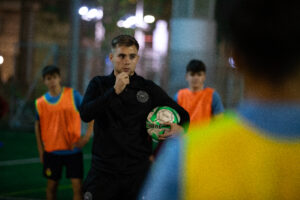Coordinative circuits are the ideal didactical strategy (DS) for the development of coordination skills in young players in the youth stage of football.
This enables different basic motor skills (BMS) such as landing mechanics, accelerations, decelerations, etc., to be worked on. In addition, it will also indirectly promote the improvement of coordination between the upper and lower trunk, reaction speed, balance and stability.
Therefore, in this article we will describe the 5 aspects that the coach must master in the design of DS to achieve a greater impact on the player.
Variety and Variability
A good coordinative circuit should include a variety of exercises that address different aspects of coordination, agility, reaction speed and balance. This will ensure a comprehensive development of the skills required in football and an indirect improvement of the player’s technique. Also, within the same task there must be variability, i.e. the coach must be able to design a DS where situations appear that are different and changing, where players must solve problems creatively and adapt to the circumstances.
Progression and Adaptability
The circuit should be designed in a way that allows players to progress gradually in terms of difficulty and complexity. The exercises should be challenging, but achievable, which will help to improve coordination skills over time. In addition, they should be adaptable to the individual needs of the players and the skill level of the team. Modifications can be made to the exercises to adapt them to the specific abilities and goals of the players, ensuring that everyone can benefit.
Necessary Equipment
Depending on the exercises included in the circuit, appropriate equipment should be provided. This may include cones, hurdles, coordination ladders, footballs, obstacles and anything else necessary to perform the exercises optimally. It is also important to have sufficient space to perform the activities safely and effectively. The area designated for the circuit should be large enough to allow for quick movements and changes of direction, avoiding obstacles that may interfere with the proper execution of the movements.
Sufficient Time
It is vital to allocate sufficient time for players to complete the circuit and execute each movement properly. The time allotted should be realistic and allow players to concentrate on correct technique and quality of execution. However, overuse of time could have adverse effects on the player.
Supervision and Feedback
A coordinative circuit requires proper supervision by coaches and physical trainers. During the practice task, they should provide clear instructions, correct technique and give constructive feedback to the players to ensure that they are performing the movements correctly and efficiently.
In conclusion, coordinative circuits in football are an effective strategy for the development of basic motor skills. During the design, it is essential to consider variety and variability within the exercise, gradual progression and adaptability, as well as constant supervision and appropriate use of time and equipment.
Click here to download an example of a coordinative circuit







